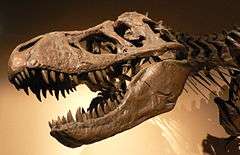Ichnology
Ichnology is the branch of geology and biology that deals with traces of organismal behavior, such as footprints and burrows. It is generally considered as a branch of paleontology; however, only one division of ichnology, paleoichnology, deals with trace fossils, while neoichnology is the study of modern traces. Parallels can often be drawn between modern traces and trace fossils, helping scientists to decode the possible behavior and anatomy of the trace-making organisms even if no body fossils can be found. An ichnologist is a scientist whose area of study and research is ichnology.
Overview
Ichnologic studies are based on the discovery and analysis of biogenic structures: features caused by living organisms. Thus, burrows, trackways, trails and borings are all examples of biogenic structures, but not casts or molds of dead shells or other bodily remains. To keep body and trace fossils nomenclatorially separate, ichnospecies are erected for trace fossils. Ichnotaxa are classified somewhat differently in zoological nomenclature than taxa based on body fossils (see trace fossil classification for more information).
Examples include:
- Late Cambrian trace fossils from intertidal settings include Protichnites and Climactichnites, amongst others
- Mesozoic dinosaur footprints including ichnogenera such as Grallator, Atreipus and Anomoepus
- Triassic to Recent termite mounds, which can encompass several square kilometers of sediment
History
Charles Darwin's The Formation of Vegetable Mould through the Action of Worms[lower-alpha 1] is an example of a very early work on ichnology, describing bioturbation and, in particular, the burrowing of earthworms.[1]
See also
References
Further reading
- ↑ Darwin, C. R. (1881), The formation of vegetable mould, through the action of worms, with observations on their habits, London: John Murray, retrieved 26 September 2014
External links
- Ichnos An International Journal for Plant and Animal Traces
